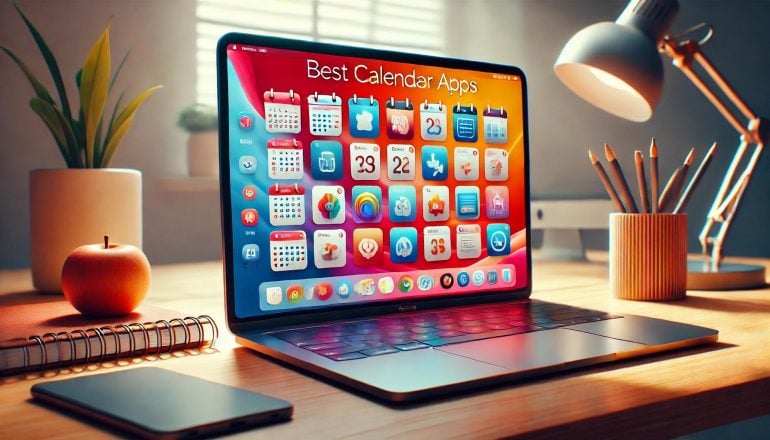-
How to Backup Your MacBook: Top 7 App Reviews and Tips

Image: Generated with Dall-EData loss is a nightmare for everyone. Whether it’s due to system failure, accidental deletion, or even theft, the risks are real.
According to a study by Backblaze, 46% of people lose data each year, 50% of hard drives die within five years, and 15% of households experience theft annually.
Learning how to backup your MacBook is not a luxury but a necessity for safeguarding your professional data. Encrypting your backups is crucial, especially when dealing with sensitive information, as it ensures that even if someone gains access to your backup files, they can’t read the data without the encryption key.
A reliable backup solution helps you quickly recover from unexpected data loss, saving time and protecting sensitive information.
Below, you’ll find a complete overview of how to backup your MacBook with the best backup apps for Mac and why options like iCloud sync are NOT a backup solution.
-
The 17 Best Freelance Apps for Mac

Image: Andrea PiacquadioAs a freelancer, having the right tools at your fingertips can make all the difference between securing clients and having opportunities slip away. Your success depends on apps that help you manage your time, streamline your workflow, boost your productivity, and keep you focused. Wondering where to start? We’ve created a list of the best freelance apps for Mac users. These solutions are designed to support you, helping you work efficiently and effectively so that you dedicate your attention to your goals.
Before you decide which tool is best for you, we recommend examining your needs closely. What specific problem are you trying to solve? Are you wondering where your time goes every day? Is a particular task taking you longer than it should? Are you battling to stay on top of your projects and meet your deadlines? Is it taking you too long to convert your quotes to invoices? Once you know exactly what issue you’re tackling, you’ll find it easier to identify the right solution from our list.
One last thing before we dive in. If you’re a Mac user, we recommend trying to use Mac native apps as much as possible. Apps that have been specifically designed with macOS in mind almost always offer a superior user experience. You get more stability, better performance and an intuitive design. They’re also sure to integrate well across all your Apple devices.
If you can’t find truly Mac native apps, make sure you look for solutions that are at least Mac friendly. All of the apps we’ve listed below fall into one of these two camps. With that, let’s take a look at some of the freelance apps for Mac you can’t live without.
-
The Best Mac Time Tracking Software for Architects

Image: energepic.com
Architects face the constant challenge of managing complex projects with tight deadlines and balancing creativity with practicality. Poor time management can lead to missed deadlines, budget overruns, and lost opportunities for architects who need to focus on both the big picture and the finer details.
Moreover, architects who work on a Mac need time tracking software that integrates seamlessly into their workflow, offering reliability, security, and ease of use.
With the right time tracking tool, time management becomes effortless and directly impacts the quality of your work, client satisfaction, and your bottom line.
In this article, we’ll discuss why time tracking for architects is essential and the top time tracking apps you can use to get a more accurate picture of how you spend your work day.
Before we start with our top picks, let’s dive into the challenges architects face.
-
The 14 Best Project Management Software for Mac

Image: fauxels
What’s the best project management software for Mac? Unfortunately, there’s no one-size-fits-all answer here. Everyone you speak to is likely to have a preference for the solution that meets their unique requirements.
To help you find the option that works best for you, we’ve put together a detailed list of the 14 best Mac project management tools. Our review provides all the information you need to make the right choice. Whether you’re a freelancer, a manager of a small team, or a business owner looking to scale, our picks will ensure you stay on track and meet your goals.
-
The Best Lawyer Time Tracking Software in 2026

Image: Generated with Dall-EAccurate time tracking is a critical yet often challenging task for lawyers. Despite its importance, many legal professionals struggle to maintain precise records, leading to revenue loss and preventing them from meeting contractual billable hour targets.
Research shows that delaying time entries can drastically reduce revenue: a 10 percent loss if recorded the same day, 25 percent after 24 hours, and 50 to 70 percent if delayed by a week. Waiting 30 days can result in losses as high as 200 to 280 percent of the potential revenue.
This inefficiency is compounded by unhelpful formats and billing conventions, forcing associates to spend excessive time on non-billable tasks, such as filling out timesheets, rather than focusing on billable work. For managing partners, this means more time is lost working within the business instead of on the business.
Below, we’ll explore some of the best lawyer time tracking software and how choosing the right one for your practice can mitigate billing issues and improve the profitability and productivity of your business.
-
The 9 Best Calendar Apps for Mac

Image: Generated with Dall-EWhether you’re arranging work meetings or personal engagements, having the best calendar app for Mac is critical to managing your time effectively. The right calendar app can help you organize your schedule, improve your productivity, and collaborate well with others. It’s an essential value-add in maintaining control of your time and spending it wisely.
But with so many calendar apps on the market, how do you find the one that’s right for you? We’ve drawn up a list of the nine best calendar apps for Mac. Each app has a few important characteristics that we recommend you look out for, as well as a couple of defining features that separate them from the rest.
-
Time Constraints: 8 Pro Tips to Help You Manage Tight Deadlines

Image: Antoni ShkrabaOur professional lives are governed by one time constraint after another. Client and self-imposed deadlines, access to resources, and our operational processes influence what we prioritize when. This isn’t necessarily a bad thing. It’s an inevitability. Every task has to be completed at some point. And if we can plan our schedules realistically and manage our workloads effectively, we can leverage these limitations properly,
Here, we offer eight useful strategies to help you navigate demanding deadlines. Their intention is to reduce the potential negative effects of time constraints, such as stress, decreasing work quality, and an inability to think creatively. And instead ensure you structure your time in a way that helps you feel in control, focused and productive.
-
Ditch the Timesheet Template: Switch to Automatic Time Tracking

Image: Generated with Dall-EAre you losing valuable billable hours because of an inefficient manual timesheet template?
Research shows that most people are only 66% accurate in logging their time once a day, and that drops to 35% if it’s done weekly.
It gets worse for meetings – 20% never track time in meetings and calls, costing professionals over $32,000 in revenue annually.
As you can see, not using timesheets or relying on manual entry can negatively impact your business’s profitability.
However, if you switch to automating your timesheet tracking, you can avoid the financial pitfalls and use technology to help you run a more efficient freelancing business.
-
Time Well Spent: What it Means and How to Get the Most Out of Every Day

Image: Nataliya VaitkevichSpending time well means different things to different people. Some associate it with productivity, personal fulfillment or self-improvement. For others, it’s about spending quality time with loved ones or helping people in need. Many associate time well spent with a good work-life balance — days that feel full and rich both professionally and personally, without being exhausting or overwhelming.
In an age when busyness is elevated, even revered, well-spent time offers a refuge. Rather than encouraging us to succumb to the pressures of constant activity, it emphasizes the quality of our experiences over the quantity. If we’re spending our time well, we’re prioritizing meaningful pursuits that enrich our lives instead of frantically ticking off an endless list of tasks.
Here, we explore the ins and outs of this concept and look into the tools that can help you get the most out of every day.
-
Why Is It Important to Set Realistic Goals? Top 6 Benefits and Tips for Success

Image: Generated with Dall-ESetting work goals can help to give you clarity and focus, boost your motivation, and increase your chances of achieving your professional ambitions. But be careful, we’re often warned, you have to make sure your goals are realistic. Why? Why is it important to set realistic goals? What are the benefits? Can’t we just aim for the stars and hope for the best?
In the minutes after midnight on 1 January every year, millions of people set goals for themselves. Within the first six months, according to recent research, 93.5% have failed in their attempts. The majority have given up before the end of February.
The reasons why we fail are numerous and complex. In some instances, we haven’t adequately prepared ourselves. We don’t really know what pursuing our goals involves or what will be required for us to succeed. In other instances, we encounter unanticipated external challenges. We fall ill, the economy changes, a pandemic hits. But among the most important reasons is that our goals simply aren’t realistic in the first place.
Here, we look into six benefits you can expect if you set realistic goals, and offer tips for making your goals a reality.
Let’s get started.
